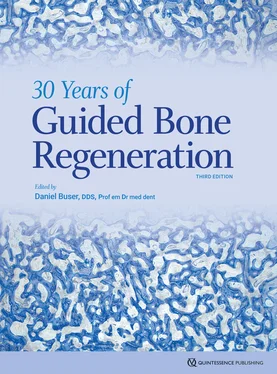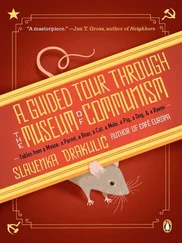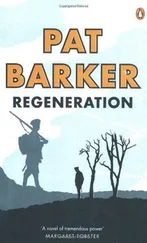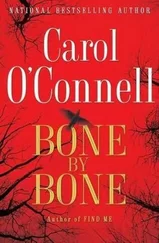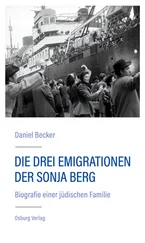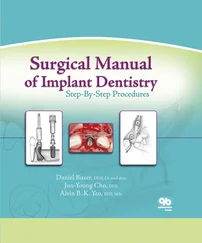Improved knowledge of tissue biology in postextraction sites
The progress in this field was initiated around 2004 to 2005 by fundamental studies on bone alterations in postextraction sites performed by the group of Lindhe et al. In the beginning, a series of experimental studies in beagle dogs helped to explain the concept of bundle bone resorption postextraction. 86 , 87 These studies were followed by a number of clinical studies using the CBCT technique (for review, see Chappuis et al 88 ). This new knowledge was fundamental for the definition of selection criteria used in postextraction implant placement. The current knowledge of hard and soft tissue alterations is discussed in detail in chapter 4, and the selection criteria for the different treatment options are presented in chapter 6.
Better understanding of the biologic characteristics of bone grafts and bone substitutes
As mentioned in a previous paragraph, autogenous bone chips had already been utilized with GBR procedures in the late 1980s, but they were used primarily as membrane support to avoid membrane collapse during healing. In the late 1990s, a first preclinical study by Buser et al 81 in minipigs showed that bone fillers have different biologic characteristics. Autogenous bone chips have excellent osteogenic potential, fostering new bone formation during early healing, and have a high substitution rate during bone remodeling. The alternative bone fillers tested were all associated with much slower bone formation during early healing, but one of them showed an interesting low substitution rate. Subsequently, a series of experimental studies with various bone fillers were conducted by Jensen et al, 89 – 91 confirming the superiority of autogenous bone chips with regard to osteogenic potential in comparison with all other bone fillers tested. In contrast, these studies showed that some bone fillers had very good volume stability with a low substitution rate, such as deproteinized bovine bone mineral (DBBM), a bovine bone filler. This new insight into the biologic properties of bone grafts and bone substitutes increasingly favored the use of two bone fillers as a so-called composite graft which can be used either as a two-layer or a mixed composite graft (see chapter 2).
In the 2010s, the characteristics of autogenous bone chips were further examined in a series of in vitro studies using cell cultures. The studies showed that these bone chips instantly release growth factors (GFs) such as transforming growth factor β1 (TGF-β1) and bone morphogenetic protein 2 (BMP-2) into the surrounding blood, both potent GFs for osteogenesis. 92 – 95 With this release of GFs, the blood containing them is called bone-conditioned medium (BCM). BCM is then able to biologically activate bone fillers and barrier membranes for GBR procedures. 96 , 97 All these details are presented in this textbook in a completely new chapter 3.
Development of new narrow-diameter implants made of a Ti-Zr alloy
Narrow-diameter implants (NDIs) made of commercially pure titanium (CPTi) were already available in the mid 1990s, but they had limited clinical applications since NDIs showed an increased fracture rate in daily practice due to fatigue fractures. 98 To reduce the risk of fracture, splinting NDIs to other implants was recommended at that time. 8 Around 2010, a new titanium-zirconium (Ti-Zr) alloy called Roxolid (Straumann) was introduced to the market. This new implant material offered much greater strength when compared with CPTi. 99 The stronger implant material was able to reduce the risk of fracture, and hence widened the range of applications in daily practice. In the meantime, NDIs became well documented by clinical studies and systematic reviews. 100 – 103 In the most recent patient pool analysis, covering 3 years (2014 to 2016) at the University of Bern, the frequency of NDIs clearly increased, to roughly 25%. 21 This means their use has remarkably more than doubled in a 6-year period. 20
The utilization of NDIs has two advantages in daily practice. First, it allows the clinician to use a standard implant placement protocol without a simultaneous GBR procedure in borderline situations with a crest width of around 6 mm. Second, in case of a local bone defect, it optimizes the defect morphology following implant placement and hence reduces the frequency of staged approach augmentation procedures. The benefit for patients is obvious, since it reduces not only morbidity, but also costs. These details are discussed in chapter 5of this textbook.
All these developments have enabled us to fine-tune the GBR technique in the past 20 years, and the details of these aspects are discussed in the clinical chapters of this book.
Summary
Over the years, significant progress has been made with GBR procedures in implant patients. GBR has not only become the standard of care for the regeneration of localized bone defects in the alveolar ridge of potential implant patients, but it has been an important contributing factor for the rapid expansion of implant therapy in the past 20 years, as well as contributing to significant progress in the field of esthetic implant dentistry.
The procedures recommended in various clinical situations are presented step-by-step in chapters 6to 13. The reader of this textbook will quickly realize that the recommended surgical techniques are rather conservative, following basic rules of bone augmentation procedures. This offers the clinician the most predictable approach to achieving a successful treatment outcome with a low risk of complications, and thus the ability to become a successful implant surgeon who is able to satisfy the high expectations of today’s patients.
References
1.Buser D, Sennerby L, De Bruyn H. Modern implant dentistry based on osseointegration: 50 years of progress, current trends and open questions. Periodontol 2000 2017;73:7–21.
2.Brånemark P-I, Adell R, Breine U, Hansson BO, Lindström J, Ohlsson A. Intra-osseous anchorage of dental prostheses. I. Experimental studies. Scand J Plast Reconstr Surg 1969;3:81–100.
3.Schroeder A, Pohler O, Sutter F. Tissue reaction to an implant of a titanium hollow cylinder with a titanium surface spray layer [in German]. SSO Schweiz Monatsschr Zahnmed 1976;86:713–727.
4.Schroeder A, van der Zypen E, Stich H, Sutter F. The reactions of bone, connective tissue, and epithelium to endosteal implants with titanium-sprayed surfaces. J Maxillofac Surg 1981;9:15–25.
5.Albrektsson T, Brånemark P-I, Hansson H-A, Lindström J. Osseointegrated titianium implants. Requirements for ensuring a long-lasting direct bone-to-implant anchorage in man. Acta Orthop Scand 1981;52:155–170.
6.Schenk RK, Buser D. Osseointegration: A reality. Periodontol 2000 1998;17:22–35.
7.Bosshardt DD, Chappuis V, Buser D. Osseointegration of titanium, titanium alloy and zirconia dental implants: Current knowledge and open questions. Periodontol 2000 2017;73:22–40.
8.Buser D, von Arx T, ten Bruggenkate C, Weingart D. Basic surgical principles with ITI implants. Clin Oral Implants Res 2000;11(suppl 1):59–68.
9.Gotfredsen K, Rostrup E, Hjörting-Hansen E, Stoltze K, Budtz-Jörgensen E. Histological and histomorphometrical evaluation of tissue reactions adjacent to endosteal implants in monkeys. Clin Oral Implants Res 1991;2:30–37.
10.Weber HP, Buser D, Donath K, Fiorellini JP, Doppalapudi V, Paquette DW, et al. Comparison of healed tissues adjacent to submerged and non-submerged unloaded titanium dental implants. A histometric study in beagle dogs. Clin Oral Implants Res 1996;7:11–19.
11.Brånemark P-I, Hansson BO, Adell R, Breine U, Lindström J, Hallén O, Ohman A. Osseointegrated implants in the treatment of the edentulous jaw. Experience from a 10-year period. Scand J Plast Reconstr Surg 1977;16(suppl):1–132.
Читать дальше
